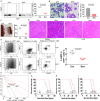Bortezomib suppresses self-renewal and leukemogenesis of leukemia stem cell by NF-ĸB-dependent inhibition of CDK6 in MLL-rearranged myeloid leukemia
- PMID: 33599085
- PMCID: PMC7957264
- DOI: 10.1111/jcmm.16377
Bortezomib suppresses self-renewal and leukemogenesis of leukemia stem cell by NF-ĸB-dependent inhibition of CDK6 in MLL-rearranged myeloid leukemia
Abstract
Acute myeloid leukaemia (AML) with chromosomal rearrangements involving the H3K4 methyltransferase mixed-lineage leukaemia (MLL) is an aggressive subtype with low overall survival. Bortezomib (Bort) is first applied in multiple myeloma. However, whether bort possesses anti-self-renewal and leukemogenesis of leukaemia stem cell (LSC) in AML with MLL rearrangements is still unclear. Here, we found that bort suppressed cell proliferation and decreased colony formation in human and murine leukaemic blasts. Besides, bort reduced the frequency and function of LSC, inhibited the progression, and extended the overall survival in MLL-AF9 (MF9) -transformed leukaemic mice. Furthermore, bort decreased the percentage of human LSC (CD34+ CD38- ) cells and extended the overall survival in AML blasts-xenografted NOD/SCID-IL2Rγ (NSG) mice. Mechanistically, cyclin dependent kinase 6 (CDK6) was identified as a bort target by RNA sequencing. Bort reduced the expressions of CDK6 by inhibiting NF ĸB recruitment to the promoter of CDK6, leading to the abolishment of NF ĸB DNA-binding activity for CDK6 promoter. Overexpression of CDK6 partially rescued bort-induced anti-leukemogenesis. Most importantly, bort had little side-effect against the normal haematological stem and progenitor cell (HSPC) and did not affect CDK6 expression in normal HSPC. In conclusion, our results suggest that bort selectively targets LSC in MLL rearrangements. Bort might be a prospective drug for AML patients bearing MLL rearrangements.
Keywords: Bortezomib; MLL rearrangements; cyclin dependent kinase 6; leukaemia stem cell.
© 2021 The Authors. Journal of Cellular and Molecular Medicine published by Foundation for Cellular and Molecular Medicine and John Wiley & Sons Ltd.
Conflict of interest statement
The authors declare that they have no competing interests.
Figures







Similar articles
-
Requirement for CDK6 in MLL-rearranged acute myeloid leukemia.Blood. 2014 Jul 3;124(1):13-23. doi: 10.1182/blood-2014-02-558114. Epub 2014 Apr 24. Blood. 2014. PMID: 24764564 Free PMC article.
-
HCK maintains the self-renewal of leukaemia stem cells via CDK6 in AML.J Exp Clin Cancer Res. 2021 Jun 24;40(1):210. doi: 10.1186/s13046-021-02007-4. J Exp Clin Cancer Res. 2021. PMID: 34167558 Free PMC article.
-
The lncRNA LAMP5-AS1 drives leukemia cell stemness by directly modulating DOT1L methyltransferase activity in MLL leukemia.J Hematol Oncol. 2020 Jun 17;13(1):78. doi: 10.1186/s13045-020-00909-y. J Hematol Oncol. 2020. PMID: 32552847 Free PMC article.
-
Mouse models of MLL leukemia: recapitulating the human disease.Blood. 2017 Apr 20;129(16):2217-2223. doi: 10.1182/blood-2016-10-691428. Epub 2017 Feb 8. Blood. 2017. PMID: 28179274 Free PMC article. Review.
-
Exploring the contribution of Zfp521/ZNF521 on primary hematopoietic stem/progenitor cells and leukemia progression.Cell Tissue Res. 2024 Dec;398(3):161-173. doi: 10.1007/s00441-024-03926-2. Epub 2024 Oct 22. Cell Tissue Res. 2024. PMID: 39436449 Free PMC article. Review.
Cited by
-
NF-κB: A Druggable Target in Acute Myeloid Leukemia.Cancers (Basel). 2022 Jul 21;14(14):3557. doi: 10.3390/cancers14143557. Cancers (Basel). 2022. PMID: 35884618 Free PMC article. Review.
-
Narazaciclib, a novel multi-kinase inhibitor with potent activity against CSF1R, FLT3 and CDK6, shows strong anti-AML activity in defined preclinical models.Sci Rep. 2024 Apr 19;14(1):9032. doi: 10.1038/s41598-024-59650-y. Sci Rep. 2024. PMID: 38641704 Free PMC article.
-
Recent Developments and Evolving Therapeutic Strategies in KMT2A-Rearranged Acute Leukemia.Cancer Med. 2024 Oct;13(20):e70326. doi: 10.1002/cam4.70326. Cancer Med. 2024. PMID: 39428967 Free PMC article. Review.
-
Leukemic Stem Cell: A Mini-Review on Clinical Perspectives.Front Oncol. 2022 Jun 24;12:931050. doi: 10.3389/fonc.2022.931050. eCollection 2022. Front Oncol. 2022. PMID: 35814466 Free PMC article. Review.
-
Divergent Processing of Cell Stress Signals as the Basis of Cancer Progression: Licensing NFκB on Chromatin.Int J Mol Sci. 2024 Aug 7;25(16):8621. doi: 10.3390/ijms25168621. Int J Mol Sci. 2024. PMID: 39201306 Free PMC article. Review.
References
-
- Krivtsov AV, Armstrong SA. MLL translocations, histone modifications and leukaemia stem‐cell development. Nat Rev Cancer. 2007;7:823‐833. - PubMed
-
- Krivtsov AV, Twomey D, Feng Z, et al. Transformation from committed progenitor to leukaemia stem cell initiated by MLL‐AF9. Nature. 2006;442:818‐822. - PubMed
-
- Kumar AR, Hudson WA, Chen W, et al. Hoxa9 influences the phenotype but not the incidence of Mll‐AF9 fusion gene leukemia. Blood. 2004;103:1823‐1828. - PubMed
Publication types
MeSH terms
Substances
Grants and funding
LinkOut - more resources
Full Text Sources
Other Literature Sources
Molecular Biology Databases
Research Materials

